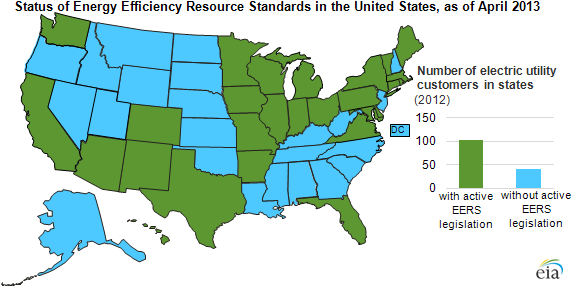
New EIA inventory tracks state energy efficiency programs

Note: Non-EERS demand side management and integrated resource planning requirements overlap inconsistently with EERS coverage.
EIA has compiled a nationwide inventory providing detailed summaries of energy efficiency evaluation reports—commonly called evaluation, measurement, and verification (EM&V) reports—on electricity and natural gas programs. This is the first such inventory available for public use, organizing useful and timely information for energy demand analysis.
Energy Efficiency Resource Standards (EERS) established by states have joined other regulatory and policy measures as a primary driver of energy efficiency programs in the United States. At the end of 2012, electric utilities in states having active EERS legislation served 104.6 million electric customers. As states and other entities ramp up incentive programs for enhancing energy efficiency, the effect of these incentives and their EM&V is critical to assessing program cost effectiveness. To some extent, the implementation of EERS follows the renewable portfolio standards. In general, energy-related state legislation is an active field, with more than 2,100 bills pending in the 50 states, according to Colorado State University's Center for the New Energy Economy and its Advanced Energy Legislation Tracker.
Energy efficiency program budgets have rapidly expanded, and in many states now approach supply-side capital investment in scale. But the diffused targeting of these programs, the lack of lengthy track records, and the difficulty of measuring their benefits make program evaluation critical. A large number of programs are currently generating an ever-growing number of EM&V studies. It is challenging to track and compare the results of so many programs or even to locate and acquire the reports on program effectiveness. EIA developed this inventory of EM&V reports to meet this challenge and to enable research and analysis of energy efficiency cost-effectiveness.
EIA's new inventory will make it easy to study cost information in state-mandated energy efficiency program evaluations. The inventory database is available to the public and enables rapid location and comparison of EM&V documents by geography, scope, and other characteristics. The database includes links to reports, associated legislation and regulations, and summary details on coverage (such as customer class and end use) for each energy efficiency program.
The database catalogues 329 data sources containing program evaluation results. These primarily were presented in annual reports to state regulatory commissions (108 documents). An additional 115 reports were designated as impact or process evaluation reports. California reports are not included in the EIA inventory because the CALMAC system already provides a ready source for EM&V information.
Tags: efficiency, electricity, map, utility